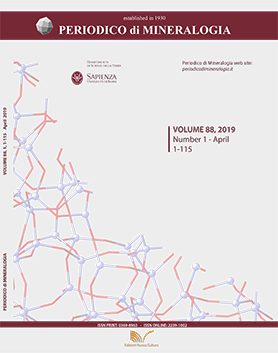Mineralogy and magnetite trace element geochemistry of the Niyasar iron ore deposit, Esfahan Province, Iran
DOI:
https://doi.org/10.2451/2019PM838Abstract
Iron mineralization occurs in Niyasar, locating 43 km at the west of Kashan city in the Esfahan Province of Iran. Geologically, it is situated within the Urumieh-Dokhtar magmatic assemblage to the north of Zagros orogenic belt. Having a total probable reserve of 1 Mt ore grading 60-65% Fe, the Niyasar deposit is currently mined in open pit. The iron orebodies occur as irregular masses, massive lenses and veins in the Eocene andesitic-basaltic tuffs. Magnetite as anhedral fine-grained crystals is the main ore mineral. Pyrite, chalcopyrite, carbonates, hematite, goethite, limonite, chlorite and quartz are also found as subordinate constituents. Chloritization, carbonatization, silicification and argilitization are the dominant alterations in the pyroclastic host rocks. Magnetites from the Niyasar deposit suggest a skarn alteration affinity based on a set of geochemical evidences including similar Cu, Mn, Mg and V concentrations to skarn mineralization, data fields in Ni/(Cr+Mn) vs. Ti+V and Ca+Al+Mn vs. Ti+V diagrams, low REE content, smooth chondrite-normalized REE pattern, slight LREE enrichment and negative Eu anomaly. On the other hand, low concentrations of V, Ti, Cr and Ni, plotted data in Ti vs. Ni/Cr diagram, LREE enrichment, and negative Ce and Eu anomalies reveal that mineralization is related to hydrothermal fluids. It is concluded here that Fe-rich hydrothermal fluids originated from widespread felsic to intermediate magmatic rocks in the Niyasar area deposited iron ores in pyroclastic rocks, by replacing the host rocks through dissolution and precipitation of magnetite.
Downloads
Published
Issue
Section
License
Copyright (c) 2019 PERIODICO di MINERALOGIA

This work is licensed under a Creative Commons Attribution 4.0 International License.


